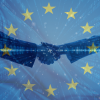By Maria Rosa Rotondo, Aline Brandstatter, Jorge Silveira Nunes and Craig Melson
Petrie, do not feel sad.
Many things do not fly–
Rocks, trees, sticks… Spike.
The Land Before Time (1988)
Some of you may have been captivated by the stunning aerial images of New York City or Madrid captured by Remotely Piloted Aircraft Systems (RPAs) or “drones” as they are more commonly known.
Leaving aside their military use, drones are not something to be scared of. They have multiple civil applications that range from agriculture or environment to border control or safety and security (not to mention art and photography!). And let us not forget about projects like Amazon Prime Air which, although rather far-fetched, are not pure science fiction.
But what is a “drone”?
The term drone is used to describe any type of aircraft that is automated and operates without a pilot on board. There are two types of drones: unmanned drones, which are automatically programmed to reach a destination and which are not allowed under both International Civil Aviation Organization (ICAO) and EU rules; and Remotely Piloted Aircraft Systems (RPAS), which consist of an aircraft controlled by a human pilot from a distant location.
Worldwide regulators have already decided to put their hands on the RPAS. The ICAO, which is the UN body responsible for civil aviation, allowed RPAS in non-segregated airspace subject to authorization by the national authorities.
In the European Union, the European Aviation Safety Agency (EASA), requires an airworthiness certification granted on a case-by-case basis under the EASA’s rules. Some Member States, have adopted legislation for simple operations by light RPAS so as to avoid this case-by-case authorization process. But the industry needs solutions on mutual recognition and specific rules for authorizations, standardization, production and operation of drones with the necessary legal safeguards in relation to safety, security, privacy and liability.
Country Outlook
In the UK, the increasing civil use of ‘drones’ challenges several existing societal norms and laws. However, police forces, local councils, and government agencies can all currently use drones unhindered.
Tom Watson MP established an All Party Parliamentary Group on drones in October 2012 which, in one of its first meetings, pointed out that the Civil Aviation Authority regulations currently do not apply to aircraft under 20 kg and also that drone use by government agencies is officially covered by the Regulation of Investigatory Powers Act (RIPA) and the Data Protection Act. The members of the APPG stated that these Acts of Parliament are not sufficient for dealing with drones, as they are often operated by those without sufficient knowledge of their data protection responsibilities.
On the contrary, the civil use of drones in Spain is forbidden, as was recently pointed out by the Spanish Air Navigation Agency. However, the Spanish Ministry of Infrastructure is currently working on a Royal Decree which will clarify certification, standardization of devices and the permissions required to fly RPAs and the conditions for those operations.
In Portugal, private companies, universities and citizens are using drones to explore opportunities, such as in Firemap (a project to identify burned forests) or in TV/cinema paparazzi-ish ventures. Despite multiple contacts with the National Institute for Civil Aviation and the National Committee on Data Protection, these aircrafts are not yet included in the political agenda but have already been identified as a target for regulation.
EU
In December 2013 the European Council asked the Commission to develop a regulatory framework for safely introducing RPAS into European civil airspace beginning in 2016.
As for the European Parliament, on the 27 February this year MEPs adopted a Resolution expressing their concerns over Member States’ willingness to develop drones for military use. They especially fear an arms race as a result of an EU with increased interest in using drones.
Subsequently, on 8th April, the European Commission called for tough standards to regulate drones. The proposed standards will cover safety, security, privacy, data protection, insurance and liability. While recognizing their contribution to society and their potential for job creation (150,000 by 2050, according to industry estimates), Vice-President Siim Kallas, Commissioner for mobility and transport, acknowledged the range of concerns that exist on this subject.
The Commission will now carry out an in-depth impact assessment to examine the issues and define the best options to address them. This may be followed by a legislative proposal, to be approved by Member States and the European Parliament. In addition, EASA can immediately start to develop the necessary safety standards.
Other measures may include support actions under existing EU programs such as SESAR, Horizon 2020 or COSME.
Drones can play an important role in Europe’s competitiveness and recovery. Through this issue, the European Union has an exciting opportunity to build a successful industry. However, it must also safeguard citizens’ rights and security. In the end, it all depends on the desire at European level to find meaningful and effective ways of dealing with this large legal grey area.
Sources:
EU:
http://europa.eu/rapid/press-release_MEMO-14-259_en.htm
http://europa.eu/rapid/press-release_IP-14-384_en.htm
http://europa.eu/rapid/press-release_STATEMENT-14-110_en.htm
UK :
SPAIN :
PORTUGAL :
http://sol.sapo.ao/inicio/Sociedade/Interior.aspx?content_id=100535






